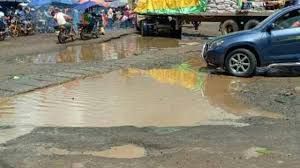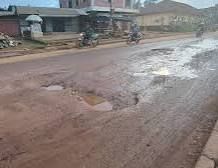
For decades, Cameroonians have suffered through a transportation nightmare that turns everyday travel into dangerous journeys. The country’s deteriorating road network has claimed countless lives, leaving grieving families and devastated communities across the nation‚ a disaster whose impact touches every level of society.
Citizens cannot travel safely on their own roads. Instead, they face dangerous stretches filled with massive potholes that can destroy vehicle parts, or smaller craters that send motorcycles flying into ditches without warning. These road hazards have made something unacceptable seem normal: people dying during regular trips.
Even Cameroon’s major cities face serious infrastructure problems. In Yaoundé, the capital’s Boulevard du 20 Mai‚ once a proud showcase road‚ now looks like a bombed-out surface of broken asphalt and exposed gravel. Douala’s Bonabéri road, the economic capital’s main commercial route, has potholes so deep that drivers joke darkly about needing boats during the rainy season. The Bafoussam-Bamenda highway, a crucial connection between the West and Northwest regions, has become a nightmare route where travel times triple and accidents happen constantly. In Bamenda, the Ntarikon stretch forces vehicles into risky single-file lines around huge holes. Even Buea’s Molyko Road‚ serving the coastal town and university area‚ has turned into a dangerous patchwork that becomes nearly impossible to use when rain transforms potholes into hidden water-filled traps.
Bad roads have become Cameroon’s most stubborn problem‚ a condition that authorities cannot or will not fix. The death toll keeps rising. Students, supposedly the nation’s future, struggle daily just to reach their schools. During the rainy season, things get much worse: children wade through knee-deep water filling road holes, risking disease; school buses get stuck in mud where pavement has completely washed away; and many students simply stop attending when roads make schools unreachable.
The October 12 presidential election came with the usual flood of promises‚ commitments to fix infrastructure, improve roads, and restore national pride. But it passed leaving only familiar silence. Campaign speeches disappeared like smoke, replaced by the same old neglect. Previous years’ broken promises pile up like layers of government lies, each layer representing abandoned commitments and wasted public money.
Instead of fixing this basic problem, authorities create new crises—distractions designed to make people forget ongoing failures. The Anglophone crisis continues, economic problems worsen, yet the regime remains stuck in either incompetence or indifference. Probably both.

Where is Cameroon going? Down roads so damaged they barely deserve to be called roads‚ both literally and as a metaphor for national decline. Until leaders care more about citizens than stealing money, until infrastructure spending matters more than personal enrichment and foreign bank accounts, Cameroonians will keep making dangerous daily trips through a country that cannot provide even this most basic public service. The roads fall apart, the promises multiply, and the people—as always—pay with their lives.


